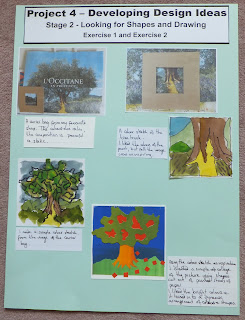Stage 3 carries on with the idea of selecting an interesting visual image with the potential for further development.
We are to collect all drawing, colour and sketchbook work done so far.
Then, using a viewing frame, look for:
- interesting marks and shapes contained within the area.
- interesting, dynamic combinations of colour, shapes and marks.
There is quite a large body of work completed so far.
There are sketches I have done, work and samples produced for each of the exercises, as well as all the colour study and texture work.
Where to begin?
I returned to a sketch that I liked previously from project 4, stage 2.
 |
| Seashells: pastel and charcoal |
This time I used a larger viewing frame for the picture.
This opened up the possibilities.
I looked at the following areas which appear to have potential.
All the images have strong light and dark contrasts.
I really like the curved shape, the way the shell is rounded.
I like the marks that are laid on the surface of the image.
The soft, curving lines are in contrast to the vertical lines caused by the grain in the paper that run through the image
 |
| Shell 1 |
This image has a strong diagonal and interesting marks.
The negative shapes, the triangles, that form the starfish are repeated around the edges of the image, giving it a cohesive look.
 |
| Shell 2 |
This image is softer and has beautiful markings.
The markings around the sides of the shell mimic the soft curves of the edges of the shape.
 |
| Shell 3 |
I then returned to project 3, stage 4, exercise 1 to one of the samples that represented the word 'calm'.
 |
| Calm: oil pastel and watercolour |
 |
| Calm: a close up |
There is a diagonal line across the image, which I feel makes it more interesting.
It has a nice mix of harmonious colours, and an even mix of deep and light blue.
The vertical lines drawn in grey oil pastel break up the image and form a contrast to the painted background.
Looking through some of my source pictures I came across one of my photos that I took when we visited the Ukraine.
 |
| The Plane Tree |
I didn't have a photo which showed the bark at its best, so I found these images on the Internet.
This image was found on the following site
I love the shapes that are created naturally by the peeling bark, and the soft grey colours which are in contrast to the bright greens.
 |
| Close up of the Plane Tree bark |
I then found another great close up of the bark on this site
The texture is now more evident and more dominant than the shapes from the previous image.
 |
| Detail of the bark |
There are some great textural marks within the picture.
There are strong light and dark contrasts.
I like the soft colours and the curving lines which are in contrast to the straight dark lines.
 |
| Using a viewing frame |
Conclusion
These are the parts of drawings that I have chosen from my collection of work.
They are all interesting for different reasons.
Having found and selected these drawings; listing the reasons why I liked the images helped to formulate some design ideas.
I had to think about:
- Whether it was the shape, colour or texture which was important.
- What it was about the composition that made it appealing
I am usually guilty of envisioning a finished product before I start.
By working my way through a slightly structured investigation into an image, the results are bound to be more interesting.
It also is a great way to stimulate some inspiration and generate some new ideas.
These images are going to be developed in Stage 4.
------------------------
Finished Page:

























































